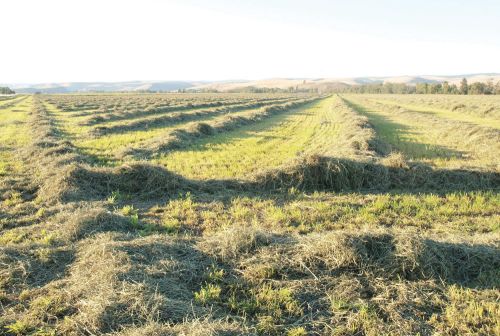OK year for hay, area’s farmers say
Published 1:21 pm Wednesday, September 11, 2013

- <p>Rocky Wilson/Chieftain Farmers in Wallowa County do their best to monitor weather conditions. A healthy crop like this raked into windrows is a valuable asset that's highly vulnerable to the elements until it's baled, and preferably stacked.</p>
If you don’t think Wallowa County farmers are independent, try interviewing four of them for a news article.
One commonality mentioned by each late in the summer of 2013 is that overall crop yields this year have been strong. But beyond that point, consensus was not the norm.
Trending
Mark Butterfield, the only president the Wallowa County Hay Growers Association has known in about eight years of existence, says the quality of crops is off this year because, put off by storms, there was a late start to haying season.
Mark and Anna Butterfield grow timothy hay, wheat, and alfalfa on 850 acres of farmland outside of Joseph.
Not far away in the Upper Valley outside of Joseph is where Mike Coppin farms about 1,000 acres on Coppin Ranch.
Like Butterfield, Coppin’s No. 1 crop is timothy hay, yet he says, “The quality and volume of crops have been good this year.”
Jon Vanderzanden, who with father Mark Vanderzanden farms AGG Inc. outside of Enterprise, says AGG primarily sells alfalfa to dairies in the area of Sunnyside, Wash., and prices for that alfalfa are “good.”
Tim Melville, a longtime Enterprise area farmer who partners with son Kurt to own Cornerstone Farms Joint Venture, says alfalfa prices are down 10-15 percent from last year. The Melvilles also sell their alfalfa to out-of-county dairies on a regular basis.
Trending
Because corn growers in the Midwest, in contrast to last summer when a drought curtailed corn harvests, are experiencing solid yields this summer, says Tim Melville, dairy operators now are buying more lower-priced corn as a feed supplement and less alfalfa.
Butterfield and Coppin agree that timothy hay is a high-value crop that grows well in the cooler temperatures of Wallowa County.
Coppin estimates that timothy hay – most of which is exported to countries such as South Korea, Japan, Saudi Arabia, and United Arab Emirates – brings in a 30 percent higher price than other local hay crops. And, he says in all seriousness, a lot of Wallowa County hay is being fed to camels.
Butterfield says prudent crop husbandry periodically necessitates crop rotations to ensure better timothy yields in future crops.
Melville, contacted while working in his shop on a rain-slowed workday, mentioned that peas and canola are good rotation crops for different reasons. A crop of peas is good at placing nutrition back into the soil, yet weak in the area of weed control, Melville says. In contrast, canola’s best value is in weed and disease control, and not in replenishing soil nutrients.
Much of the summer has been hot and dry, and that was an issue addressed by Vanderzanden. He said high temperatures were great for growing crops, “but a challenge to keep crops watered with irrigation.” AGG began utilizing its combination of irrigation wheel line and hand lines in May, Vanderzanden said.
Yet the disparity from one farmer to the next is best exemplified through the most basic of topics: weather.
“We’ve missed most of the rain showers,” says Vanderzanden, speaking of times AGG crops were down in the field and vulnerable to rain.
In contrast, Butterfield says, “There have been timely rains at the wrong times.”









